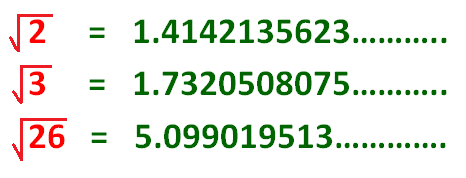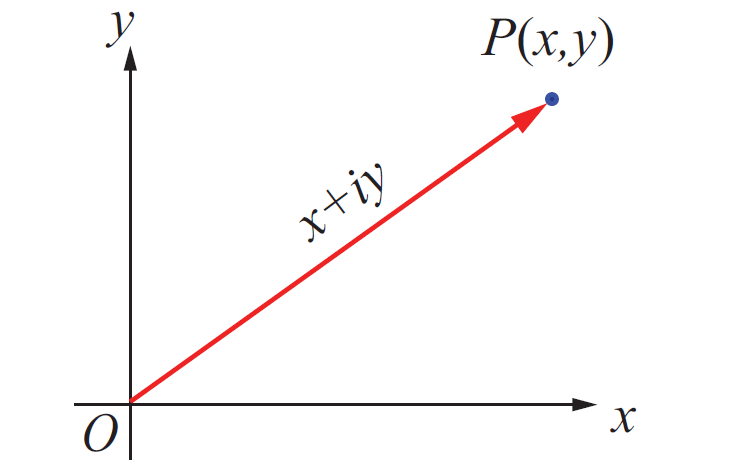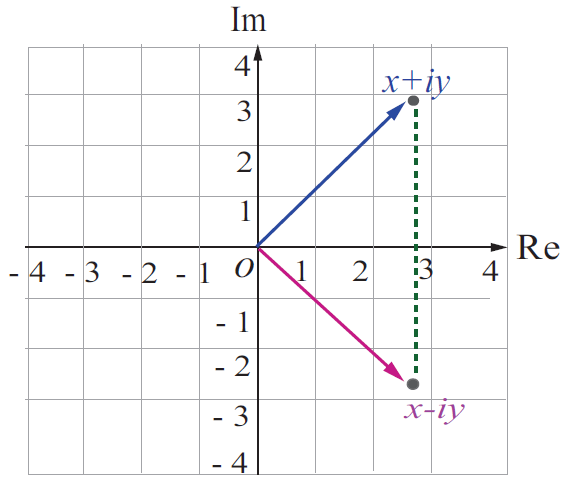NON TERMINATING, NON RECURRING DECIMALS
A non-terminating, non-repeating decimal is a decimal number that continues infinitely without repeated pattern of digits.
Decimals of this type cannot be converted to fractions, and as a result are irrational numbers.

All the above decimal numbers are irrational and they can not be converted to fractions.
How do we have this kind of non recurring decimals in Math ?
When we are trying to find square of a number which is not a perfect square, we get this kind non terminating, non recurring decimals.
Note :
A non terminating decimal can be converted to a fraction, only if it has repeated pattern.
How to convert non terminating, recurring decimals to fractions ?
1. Make sure that there are only recurring digits after the decimal point.
2. If there is only one digit in the recurring pattern, subtract 1 from 10, the result is 9.
3. Take the recurring digit in the numerator and 9 in the denominator.
4. Simplify the fraction, as needed.
Note :
If there are two digits in the recurring pattern, subtract 1 from 100, for three digits, subtract 1 from 1000 and so on. Continue the rest of the process as explained above.
In the following examples, convert the non terminating, recurring decimals to fractions :
Example 1 :
0.33333..........
Solution :
There are only recurring digits after the decimal point in
0.33333..........
There is only one digit in the recurring pattern, that is 3.
Subtract 1 from 10, the result is 9.
Write a fraction with numerator 3 and denominator 9.
= 3/9
= 1/3
Example 2 :
0.77777..........
Solution :
There are only recurring digits after the decimal point in
0.77777..........
There is only one digit in the recurring pattern, that is 7.
Subtract 1 from 10, the result is 9.
Write a fraction with numerator 7 and denominator 9.
= 7/9
Example 3 :
0.36363636..........
Solution :
There are only recurring digits after the decimal point in
0.36363636..........
There are two digits in the recurring pattern, that is 36.
Subtract 1 from 100, the result is 99.
Write a fraction with numerator 36 and denominator 99.
= 36/99
= 4/11
Example 4 :
0.507507507507..........
Solution :
There are only recurring digits after the decimal point in
0.507507507507..........
There are three digits in the recurring pattern, that is 507.
Subtract 1 from 1000, the result is 999.
Write a fraction with numerator 507 and denominator 999.
= 507/999
= 169/333
Example 5 :
0.06666..........
Solution :
There is one digit between the decimal point and the recurring digits, that is 0.
0.06666.......... = (0.6666..........) ÷ 10 ----(1)
There are only recurring digits after the decimal point in
0.6666..........
There is only one digit in the recurring pattern, that is 6.
Subtract 1 from 10, the result is 9.
Write a fraction with numerator 6 and denominator 9 for 0.6666.......... in (1).
0.06666.......... = (6/9) ÷ 10
= (2/3) ÷ (10/1)
= (2/3) ⋅ (1/10)
= (2 ⋅ 1)/(3 ⋅ 10)
= 2/30
= 1/15
Example 6 :
0.00151515..........
Solution :
There are two digits between the decimal point and the recurring digits, that is 00.
0.00151515.......... = (0.151515..........) ÷ 100 ----(1)
There are only recurring digits after the decimal point in
0.151515..........
There are two digits in the recurring pattern, that is 15.
Subtract 1 from 100, the result is 99.
Write a fraction with numerator 15 and denominator 99 for 0.151515.......... in (1).
0.00151515.......... = (15/99) ÷ 100
= (5/33) ÷ (100/1)
= (5/33) ⋅ (1/100)
= (5 ⋅ 1)/(33 ⋅ 100)
= 5/3300
= 1/660
Example 7 :
0.37777..........
Solution :
There is one digit between the decimal point and the recurring digits, that is 3.
0.37777.......... = 0.3 + 0.07777..........
In 0.07777.........., there is one digit between the decimal point and the recurring digits, that is 0.
0.37777.......... = 0.3 + (0.7777..........) ÷ 10 ----(1)
There are only recurring digits after the decimal point in
0.7777..........
There is only one digit in the recurring pattern, that is 7.
Subtract 1 from 10, the result is 9.
Write a fraction with numerator 7 and denominator 9 for 0.7777.......... in (1).
0.39999.......... = 0.3 + (7/9) ÷ 10
= 3/10 + 7/90
= 27/90 + 7/90
= (27 + 7)/90
= 34/90
= 17/45
Example 8 :
1.21212121..........
Solution :
1.21212121.......... = 1 + 0.21212121.......... ----(1)
There are only recurring digits after the decimal point in
0.21212121..........
There are two digits in the recurring pattern, that is 21.
Subtract 1 from 100, the result is 99.
Write a fraction with numerator 21 and denominator 99 for 0.21212121.......... in (1).
1.21212121.......... = 1 + 21/99
= 1 + 7/33
= 33/33 + 7/33
= (33 + 7)/33
= 40/33
Example 9 :
2.342342342..........
Solution :
2.342342342.......... = 2 + 0.342342342.......... ----(1)
There are only recurring digits after the decimal point in
0.342342342..........
There are three digits in the recurring pattern, that is 342.
Subtract 1 from 1000, the result is 999.
Write a fraction with numerator 342 and denominator 999 for 0.342342342.......... in (1).
2.342342342.......... = 2 + 342/999
= 2 + 38/111
= 222/111 + 38/111
= (222 + 38)/111
= 260/111
Example 10 :
2.05555..........
Solution :
2.05555.......... = 2 + 0.05555.......... ----(1)
In 0.05555.........., there is one digit between the decimal point and the recurring digits, that is 0.
2.05555.......... = 2 + (0.5555..........) ÷ 10 ----(1)
There are only recurring digits after the decimal point in
0.5555..........
There is only one digit in the recurring pattern, that is 5.
Subtract 1 from 10, the result is 9.
Write a fraction with numerator 5 and denominator 9 for 0.5555.......... in (1).
2.05555.......... = 2 + (5/9) ÷ 10
= 2 + 5/90
= 2 + 1/18
= 36/18 + 1/18
= (36 + 1)/18
= 37/18
Kindly mail your feedback to v4formath@gmail.com
We always appreciate your feedback.
©All rights reserved. onlinemath4all.com
Recent Articles
-
First Fundamental Theorem of Calculus - Part 1
Apr 17, 24 11:27 PM
First Fundamental Theorem of Calculus - Part 1 -
Polar Form of a Complex Number
Apr 16, 24 09:28 AM
Polar Form of a Complex Number -
Conjugate of a Complex Number
Apr 15, 24 11:17 PM
Conjugate of a Complex Number

